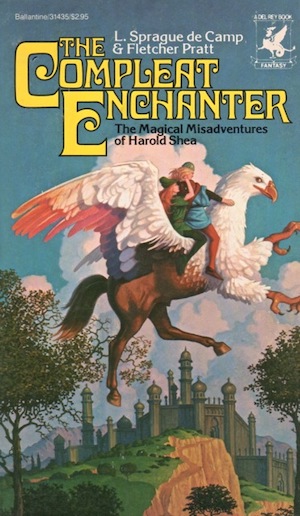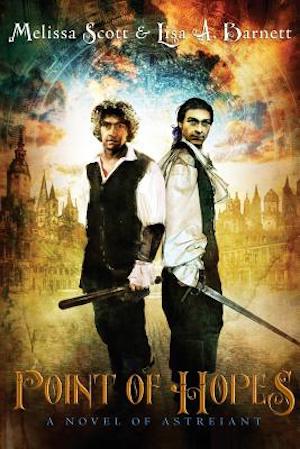The writing of prose is often depicted as a solitary activity, an occupation suited to hermits sealed into poorly lit garrets, sliding their manuscripts out under their front door, receiving flat food under the same door. Now this can be a perfectly functional approach to writing…but it is not the only one. Many authors not only appear in public, but they also write with others. If these writing partners have complementary strengths1, the pair can produce marvelous works neither could have written alone…
I hasten to add that some collaborations have produced utter dreck. I’m going to tell you about five that worked well… at least for me.
“The Twonky” by C. L. Moore & Henry Kuttner (1952)
Kerry and Martha Westerfield are a very modern American couple. That means keeping up with all the technological marvels that mid-20th-century America has to offer. Thus, their new radio is the very latest model. In fact, thanks to a hapless workman’s misadventure in time, their radio is the very latest model of an era as yet far in the Westerfields’ future.
The Twonky looks like a radio but it offers so much more than simple radio reception. Conscious of its users’ needs in a way no 20th-century gadget could be, equipped with mechanisms unmatched in that era, the Twonky will cater to the Westerfields in ways that extend beyond their wildest nightmares. Whether they want it to or not.
***
The Compleat Enchanter by L. Sprague de Camp & Fletcher Pratt

Psychologist Reed Chalmers has a bold hypothesis. Many people who are labelled mad are not mad at all. Their minds are simply in synch with the wrong universe. Align their cognitive processes with the realm in which they are resident and they would be as rational as you or I.
The hypothesis suggests an interesting experiment. Could someone align their thought processes to another universe and be transported there? Chalmers is too prudent to try this himself. His friend Harold Shea, on the other hand, is far bolder than he is cautious. One thought experiment later and Shea is up to his eyeballs in Irish mythology.
If Shea survives, it will be his first foray into worlds of wonder. If he does not, at least Irish mythology ensures an interesting demise.
***
Gladiator-At-Law by Frederik Pohl & C. M. Kornbluth (1954)

America of tomorrow is a virtual utopia—at least for the wealthy and those useful to the ruling class. The GML corporation’s highly advanced “bubble houses” provide domestic paradise to the deserving. The undeserving are consigned to the squalid post-war suburbs, where they provide a valuable example of what grim fate awaits the unsuccessful, the useless—and worst of all, would-be reformers.
Norma and Donald Lavin have a simple dream: recover the GML stocks Donald hid before being mind-wiped. This will give them 25 percent of the company and allow them to escape from the notorious Belly Rave suburban slum. At present, however, their resources are meager. Their lawyer is a no-hoper named Charles Mundin and his first plan only led to Norma’s kidnapping.
The odds that Mundin can help the Lavins appear quite slim. But a slim chance is still a chance. Mundin and all of his Belly Rave allies are prepared to go all out in pursuit of the unlikely.
***
Point of Hopes by Melissa Scott & Lisa A. Barnett (1995)

What begins for Pointsman Rathe as a simple case of a missing apprentice soon takes on far more ominous significance. Eighty of the city of Astreiant’s children have vanished. A handful of runaways might be expected, but eighty suggests kidnapping on an unprecedented scale.
Rathe rules out the conventional reasons for kidnapping. No ransoms are being demanded. The victims are not being sold as slaves of any kind. Rathe takes no comfort from this. As awful as exploitation and enslavement are, they are problems Rathe understands. Whoever has taken the children, they have done so for a dark purpose Rathe cannot guess. His only hope of rescuing the children is to figure out why this is happening…and who is doing it.
***
HWJN by Ibraheem Abbas & Yasser Bahjatt (2013)

Devout Hawjan does not dislike humans, as do so many of his fellow jinn. Indeed, he is barely aware of them. They live in different worlds and operate on vastly different time scales. Mortal humans age and die far too quickly for a jinn to truly get to know any of them well.
Hawjan’s life changes when the home that he and his family inhabit is haunted by humans, namely Dr. Abdulraheem Saeed and his family. Hawjan becomes obsessed with the doctor’s daughter, Sawsan. Unable to stop thinking about this mortal, purehearted but dim Hawjan convinces himself that he must be in love with the human.
Jinn-human relationships are forbidden for good reason. Not that the Jinn is likely to be entangled with the beautiful Sawsan for long, for she is dying. Saving her from terminal illness may demand from Hawjan more than mere social transgression. It may entice him to embrace the dark arts.
***
No doubt some of you feel I’ve overlooked some obvious examples and even now are planning on coming down on me like Lucifer’s hammer. Perhaps I focused on some mote in your eye while overlooking a beam in mine, but I’m no fallen angel and I stand by my choices. Nevertheless, the comments are below.
In the words of Wikipedia editor TexasAndroid, prolific book reviewer and perennial Darwin Award nominee James Davis Nicoll is of “questionable notability.” His work has appeared in Publishers Weekly and Romantic Times as well as on his own websites, James Nicoll Reviews and the Aurora finalist Young People Read Old SFF (where he is assisted by editor Karen Lofstrom and web person Adrienne L. Travis). He is a four-time finalist for the Best Fan Writer Hugo Award and is surprisingly flammable.
[1]I’m not going to discuss collaborations in which a living author attaches themselves to a dead author’s body of work. While I can think of many such partnerships in which the living author of the pair was motivated by something more than mere greed (such as legitimate homage), I cannot think of many successful necrolaborations I’ve enjoyed.










